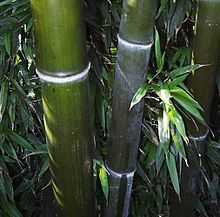Phyllostachys
| Phyllostachys | |
|---|---|
 | |
| Phyllostachys nigra | |
| Scientific classification | |
| Kingdom: | Plantae |
| (unranked): | Angiosperms |
| (unranked): | Monocots |
| (unranked): | Commelinids |
| Order: | Poales |
| Family: | Poaceae |
| Subfamily: | Bambusoideae |
| Supertribe: | Bambusodae |
| Tribe: | Bambuseae |
| Subtribe: | Shibataeinae |
| Genus: | Phyllostachys Siebold & Zucc. |
Phyllostachys (/ˌfɪlɵˈstækɨs/[1] or /ˌfɪlɵˈsteɪkɨs/[2]) is a genus of bamboo. The species are native to Asia with a large number of species found in Central China, but can now be found in many warm temperate and subtropical areas around the world as cultivated plants or escapes from cultivation. Most of the species spread aggressively by underground rhizomes.
The stem or culm has a prominent groove, called a sulcus, that runs along the length of each segment (or internode). Because of this it is one of the most easily identifiable genera of bamboo.
There are approximately 75 species and 200 varieties and cultivars of Phyllostachys. The largest grow to be about 100 feet (30 m) tall in optimum conditions. Some of the larger species, sometimes known as "timber bamboo", are used as construction timber and for making furniture.
The name Phyllostachys means "leaf spike" and refers to the inflorescences.[3]
Some of the smaller species can be grown as bonsai.
Species
- Phyllostachys acuta
- Phyllostachys angusta
- Phyllostachys arcana
- Phyllostachys atrovaginata (formerly known as Phyllostachys congesta)
- Phyllostachys aurea
- Phyllostachys aureosulcata
- Phyllostachys bambusoides
- Phyllostachys bissetii
- Phyllostachys decora
- Phyllostachys dulcis
- Phyllostachys edulis
- Phyllostachys elegans
- Phyllostachys flexuosa
- Phyllostachys glauca
- Phyllostachys heteroclada
- Phyllostachys humilis
- Phyllostachys iridescens
- Phyllostachys lithophila
- Phyllostachys makinoi
- Phyllostachys mannii
- Phyllostachys meyeri
- Phyllostachys nidularia
- Phyllostachys nigra
- Phyllostachys nuda
- Phyllostachys parvifolia
- Phyllostachys platyglossa
- Phyllostachys praecox
- Phyllostachys propinqua
- Phyllostachys pubescens
- Phyllostachys purpurata
- Phyllostachys robustiramea
- Phyllostachys rubromarginata
- Phyllostachys stimulosa
- Phyllostachys violascens
- Phyllostachys virella
- Phyllostachys viridiglaucescens
- Phyllostachys viridis
- Phyllostachys vivax
Ecology
Fungi and pathogens growing specifically on Phyllostachys have phyllostachydis or phyllostachydicola species names.
References
- ↑ "Pronunciation Guide for Plants". Retrieved 2012-07-11.
- ↑ "Pronunciation of phyllostachys". Retrieved 2012-07-11.
- ↑ Coombes, Allen J. (2012). The A to Z of plant names. USA: Timber Press. p. 312. ISBN 9781604694962 Check
|isbn=value (help).
- Zheng-ping Wang & Chris Stapleton Flora of China, Volume 22: Poaceae., Science Press u. a., Beijing u. a. 20
External links
- "Phyllostachys Siebold & Zucc.". Tropicos.org. Missouri Botanical Garden. Retrieved 2012-07-30.
- http://delta-intkey.com/grass/www/phyllost.htm
![]() Media related to Phyllostachys at Wikimedia Commons
Media related to Phyllostachys at Wikimedia Commons
| Wikispecies has information related to: Phyllostachys |